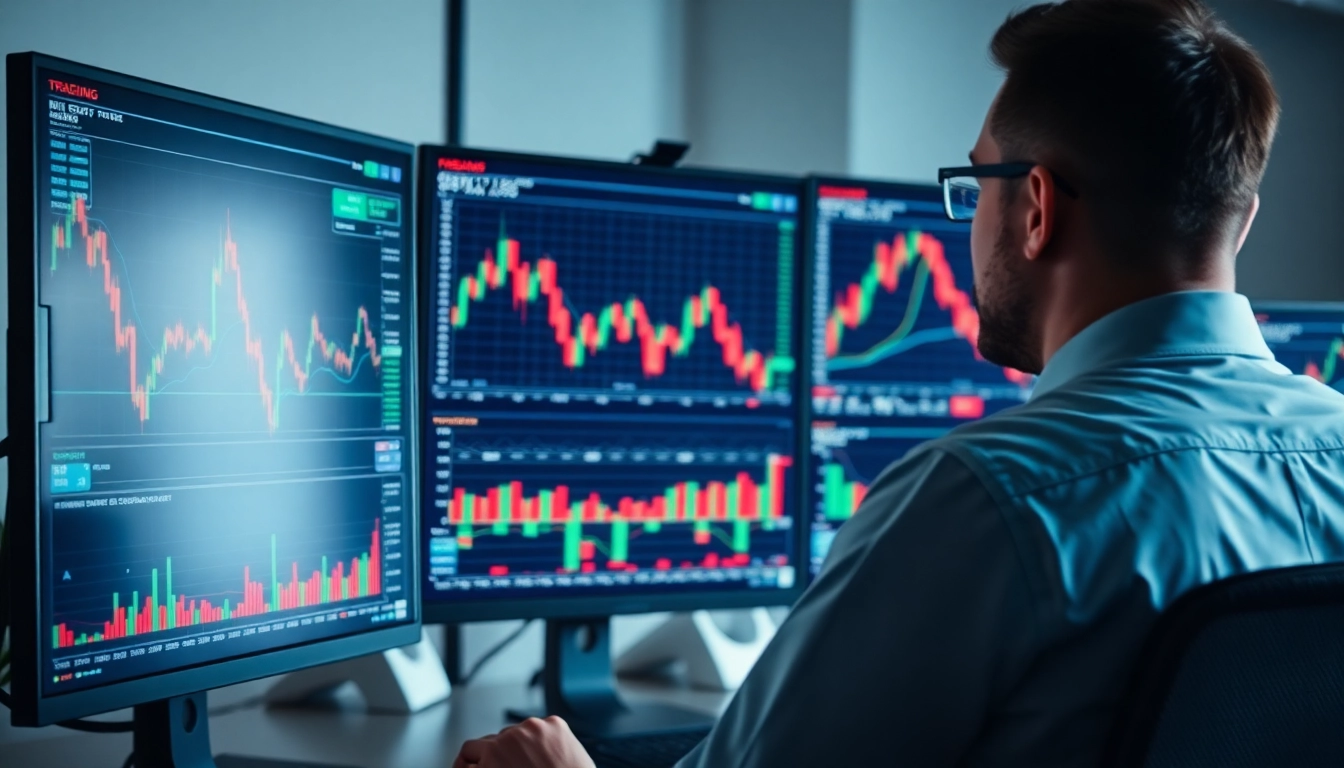Understanding the Trading View Platform and Its Features
In the fast-paced world of modern trading, having a reliable, versatile, and comprehensive charting platform is essential for both novice and experienced traders. One such leading platform that has garnered immense popularity is trading view. Known for its powerful tools, user-friendly interface, and vibrant social community, TradingView serves as an all-in-one solution for market analysis, trading, and shared insights. This section explores the core tools of TradingView, how to customize charts for enhanced insights, and its social trading features that foster learning and collaboration among traders worldwide.
Overview of Trading View’s Core Tools
TradingView offers a vast suite of tools tailored to meet the needs of traders and investors. Its core features include advanced charting capabilities, real-time data feeds across multiple markets, and a robust scripting environment for custom indicators. The platform’s charts support a variety of timeframes, from minutes to decades, accommodating different trading styles such as day trading, swing trading, or long-term investing.
One of TradingView’s standout features is its extensive library of technical indicators—over 100 built-in tools, including moving averages, RSI, MACD, Bollinger Bands, and Fibonacci retracements—that can be combined, customized, and applied to charts seamlessly. The platform also supports drawing tools like trend lines, channels, and shapes, allowing traders to visually analyze price patterns and potential breakout points.
Additionally, TradingView integrates real-time news feeds, economic calendars, and sentiment data, providing a comprehensive environment for market analysis. Its cloud-based architecture ensures that all working setups and preferences are synchronized across devices, whether accessed via web or mobile apps.
Customizing Charts for Better Insights
Customization is key to effective technical analysis, and TradingView excels in this regard. Users can tailor their charts by selecting preferred chart types—candlestick, bar, line, or area charts—to best suit their analysis style. The platform’s customizable watchlists enable traders to monitor selected assets effortlessly, which can be organized into categories or strategies.
Color schemes, grid layouts, and timeframes can be adjusted to enhance clarity. For example, traders analyzing volatile cryptocurrencies may prefer bold colors and intra-day timeframes, while long-term investors might opt for weekly or monthly charts with subdued color palettes.
Another powerful feature is the ability to save multiple chart layouts. Traders can create specific setups for different markets or strategies, switch between them with a click, and even share them with the community or team members. This level of customization accelerates decision-making processes and helps traders develop personalized workflows.
Utilizing Trading View’s Social Trading Features
Beyond its technical tools, TradingView’s social features foster a vibrant community of traders and investors. Its social network allows users to publish their analyses, share trading ideas, and discuss market developments in real time. This connectivity creates an enriching environment for peer learning, mentorship, and idea validation.
Users can follow top traders, comment on shared ideas, and participate in discussions within chart comment sections or dedicated chat groups. The platform also supports public and private sharing of charts, which is invaluable for collaborative analysis and strategy refinement.
Moreover, the social element includes a ranking system based on idea popularity and community engagement, incentivizing high-quality content. Many traders leverage this ecosystem to gain insights, spot emerging market trends, and refine their strategies based on community feedback.
How to Use Trading View for Effective Market Analysis
Analyzing Stocks, Cryptocurrencies, and Forex
TradingView’s multi-asset platform makes it straightforward to analyze a diverse array of markets—stocks, cryptocurrencies, forex, commodities, and indices—all within a unified interface. Each asset class requires tailored approaches; for instance, stocks often rely on fundamental analysis in conjunction with technicals, while cryptocurrencies need rapid, real-time charting due to their volatility.
For effective analysis, traders start by selecting relevant timeframes and applying appropriate technical indicators. They then examine key support and resistance levels, identify chart patterns such as head and shoulders or triangles, and consider volume trends. The platform’s multi-pane layout allows simultaneous comparison of assets or indicators, providing deeper insights into market correlations.
Implementing Technical Indicators and Drawing Tools
Technical indicators are at the heart of TradingView’s analytical capabilities. Traders should familiarize themselves with a combination of trend indicators (like moving averages), momentum oscillators (RSI, Stochastics), and volatility measures (Bollinger Bands). Using these tools in tandem helps validate trade signals and improves accuracy.
Drawing tools add a complementary visual dimension—trend lines illustrate breakout points; Fibonacci retracements identify potential reversal zones; channels and geometric shapes help in pattern recognition. Applying these tools smartly can improve timing and risk management when executing trades.
Pro tips include customizing indicator parameters to match asset volatility and using color coding for quick visual cues. Regular practice with drawing tools enhances pattern recognition efficiency, vital for timely trade entries and exits.
Setting Alerts and Notifications to Maximize Opportunities
One of TradingView’s most beneficial features is its alert system. Traders can set alerts based on price levels, indicator conditions, or drawing tool patterns. These notifications can be received via email, pop-ups, or mobile push notifications, ensuring traders never miss critical market moves.
To optimize alerts, traders should calibrate them to suit their trading timeframe—short-term traders may prefer alerts for intra-day price swings, while long-term investors set strategic levels. Combining multiple alerts around key economic events or earnings reports can further capitalize on market volatility.
Consistent alert management enhances discipline, reduces emotional trading, and frees traders to focus on strategic analysis rather than constantly monitoring markets.
Advanced Strategies for Trading View Success
Integrating Trading View with Your Trading Workflow
Maximizing TradingView’s potential often involves integrating it seamlessly into your overall trading process. This includes linking your broker accounts with TradingView’s trading execution features, enabling one-click orders based on technical analysis outcomes. Many brokers support direct TradingView integration, streamlining order placement and management.
Additionally, traders can automate parts of their analysis by leveraging TradingView’s API and webhook capabilities, connecting with third-party trading bots or custom scripts to execute strategies dynamically.
Using Scripts and Custom Indicators
TradingView’s built-in Pine Script language empowers traders to develop and deploy custom indicators, strategies, and alerts. Creating tailored scripts can exploit unique trading philosophies or adapt to specific assets’ behavior, providing a competitive edge.
For example, traders can code their proprietary oscillators, pattern recognition algorithms, or risk management tools. The TradingView community is rich with shared scripts, making it easy to adapt proven ideas into your own workflow.
Backtesting Strategies Within Trading View
Backtesting is crucial for validating strategies before risking real capital. TradingView’s strategy tester allows traders to simulate trades based on historical data, evaluate performance metrics, and optimize parameters. This rigorous testing can reveal strengths and weaknesses, reducing the risk of costly mistakes in live trading.
Developers can script automated strategies, apply them over different timeframes and assets, and iterate rapidly to achieve better results. Consistent backtesting and refinement underpin disciplined trading and improved profitability over time.
Enhancing Your Trading Performance with Trading View
Best Practices for Market Monitoring
Effective traders prioritize constant, organized market monitoring. TradingView’s alert system, combined with customizable dashboards, helps maintain situational awareness. Setting up real-time watchlists tailored to trading plans, along with scheduled scans for particular conditions, enhances responsiveness.
Implementing routine analysis sessions, using templates for different markets, and employing multi-timeframe analysis lead to more informed decisions and timely entries and exits.
Leveraging Community Insights and Social Trading
The community-driven aspect of TradingView is a significant advantage. By engaging with top traders’ ideas, participating in discussions, and reviewing diverse perspectives, traders can refine their strategies and avoid common pitfalls. The shared public ideas serve as informal case studies, offering real-world examples of technical setups and market reactions.
Adapting community insights prudently requires critical thinking. Use them as supplementary tools alongside your analysis rather than sole decision-makers.
Measuring and Improving Your Trading Results
Tracking performance metrics such as win rate, risk-to-reward ratio, and drawdown within TradingView or your trading journal is essential. Regular review enables identification of consistent errors or biases, facilitating targeted improvements.
Using TradingView’s data visualization tools, traders can analyze trading patterns, assess strategy robustness, and refine their approach iteratively. Discipline in measuring outcomes translates directly into elevated trading performance over the long term.
Future Trends and Continuous Learning in Market Analysis
Emerging Features in Trading View
TradingView continuously evolves, integrating features like AI-powered analysis, integrated news aggregation, and enhanced collaborative tools. Upcoming developments aim to improve automation, sentiment analysis, and real-time data feeds, providing traders with even more strategic resources.
Staying Updated with Market News and Trends
Staying informed necessitates combining TradingView’s embedded news services with external sources such as economic calendars, social media, and industry reports. This holistic approach ensures traders are aware of macroeconomic shifts, geopolitical developments, and sector-specific news impacting markets.
Resources for Ongoing Trading Education
Continual learning is vital. TradingView offers a rich repository of educational content, webinars, and tutorials. Engaging with online courses, trading communities, and mentorship programs further deepens expertise and adaptability, keeping traders ahead of emerging trends and technologies.



